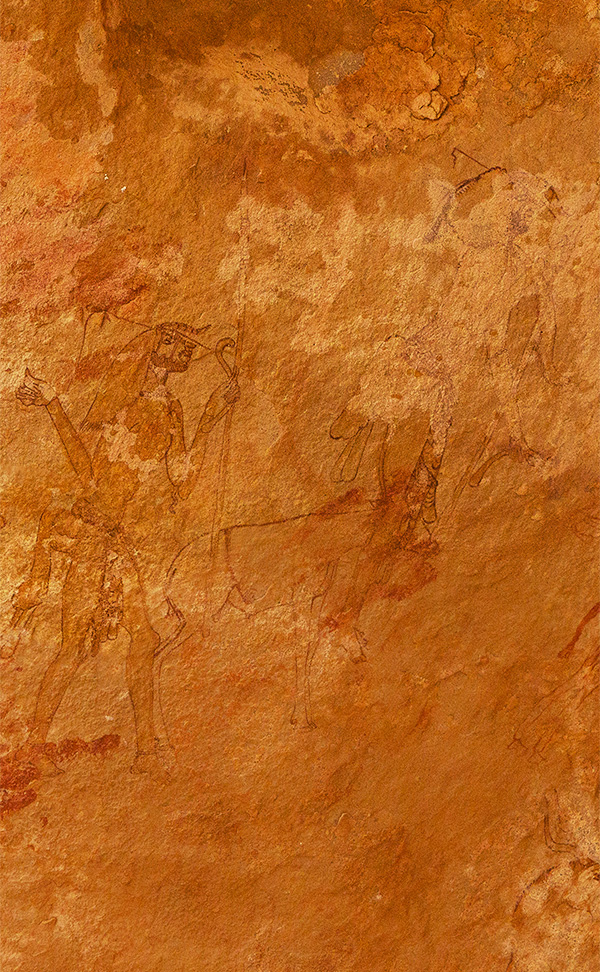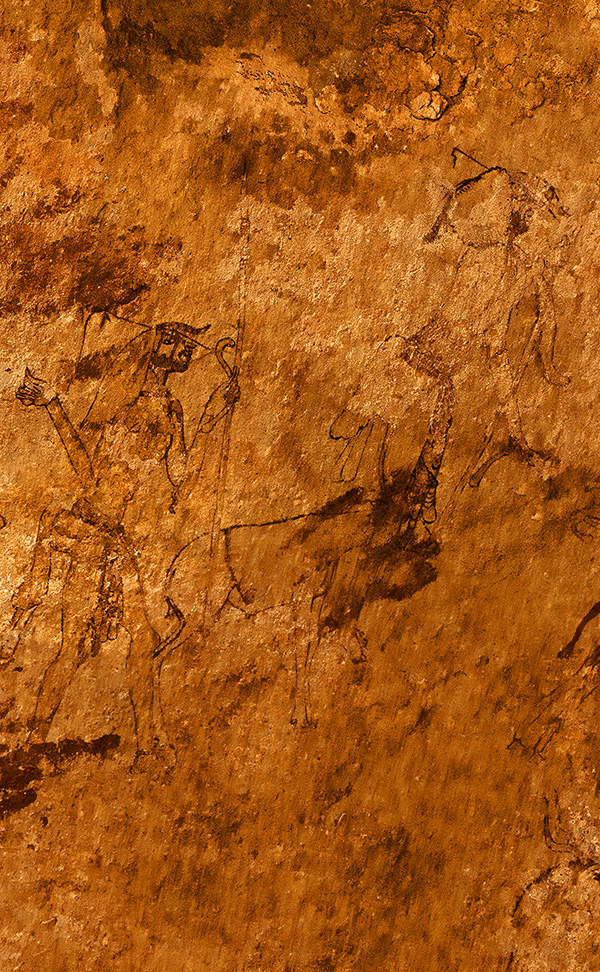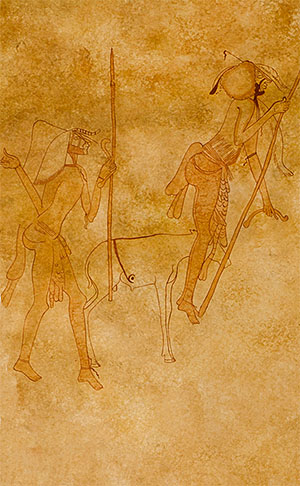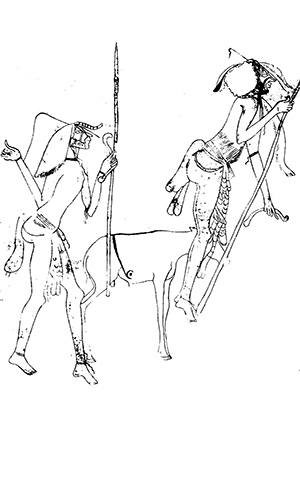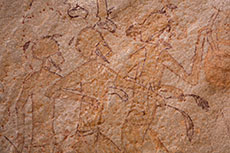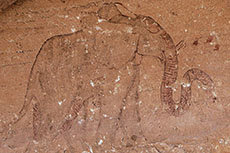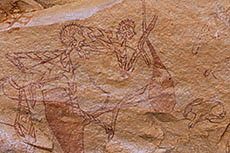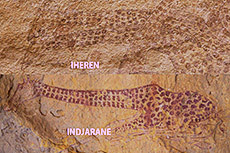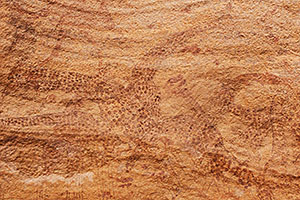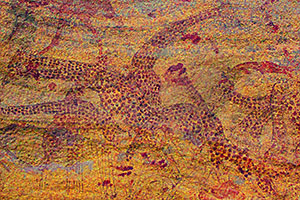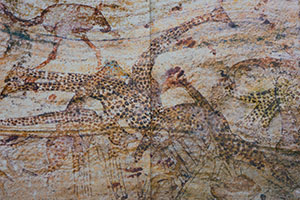In the heart of the Sahara, there is a plateau called Tassili n’Ajjer where over 15,000 paintings and engravings are found over the area of 72,000sq. km and this area is listed as a World Heritage site. These rock arts are the memory of the past populations, from about 6,000BCE to the first centuries of the current era, during the time when the Sahara was verdant until it became desert. Tassili n’Ajjer has a meaning of “Plateau with water” in the local Tuareg language. The plateau was a crossroad of various peoples and they left their own rock arts.
In Iheren, located in the northwest part of Tassili n’Ajjer, there is a marvelous prehistoric rock painting drawn by a pastoral people probably coming from the Mediterranean seaside. There is no absolute dating available for this fresco but according to the dominant theory is thought to date from around 3,000BCE.
The fresco of Iheren is so unique and special. On a rock surface of 3 meters by 9 meters, various scenes of the life of the pastoral people are depicted with extreme fineness. “The most brilliant work found so far in the Sahara, the master piece of the School of the Neolithic naturalist” as commented by Henri Lhote, one of the first explorers who investigated thoroughly the rock arts of Tassili n’Ajjer, in his book Toward other Tassili (Vers d’autres Tassili). It is amazing that such fine art was realized by prehistoric nomadic people who were far away from any dynastic power.
Iheren is far away from the touristic area and it is very seldom visited. The fresco of Iheren is not known by the public despite its highly appreciable artistic quality and its historical value.
サハラ砂漠の中心部にタッシリ・ナジェールと呼ばれる荒涼とした台地がある。72,000平方キロの地域に15,000以上の岩壁画(自然の岩に描かれた彩画や刻画)があり、世界文化遺産に指定されている。これらの岩壁画は紀元前6,000年ごろから、紀元ごろまでにいた人々が遺したものであり、この間サハラは緑に覆われていた。タッシリ・ナジェールとは現在の住民であるツアレグ族の言葉で「川のある台地」を意味する。台地は民族の十字路でもあり、様々な民族が来てはそれぞれ独自の岩壁画を遺している。
タッシリ・ナジェール台地の北西に位置するイヘーレンには、地中海沿岸地域から渡来したと考えられる白人系遊牧民族によって描かれた岩壁画が遺されている。この壁画が描かれたのは、紀元前3,000年前後と推定されている。
イヘーレン岩壁画は、非常にユニークで特別なものだ。3m x 9mの岩面に、遊牧民の様々な生活場面が繊細な筆遣いで見事に描かれている。タッシリ・ナジェールの岩壁画の詳細な調査を初めて実施したアンリ・ロートは、「今までにサハラで発見された最も優れた作品であり、新石器時代自然主義派の代表作」と称賛している。描かれた年代はエジプトの古代王朝の時代だが、エジプトから遠く離れた地で王朝などとは無縁と思われる遊牧民によって描かれたことに驚かされる。
イヘーレンは観光エリアから遠く離れて訪れる人も殆どいない。また、これほど優れた先史美術作品ではあるが一般には殆ど知られていない。
| Actual photo | Enhanced by DSTRETCH | Tracing by Lhote mission | Outline of Composed Tracings |
1) PANORAMIC PHOTOGRAPHY
145 digital images are combined. The panoramic technique requires many shots from a camera positioned in a fixed point. Some distortion is therefore inevitable due to the angle of the objects, the distance of the objects, the applied projection method, etc. The definition is reduced by half (1/2×1/2=1/4) to relieve the data volume in the server.
2) ENHANCED IMAGE
Same photo is digitally processed in order to enhance the image for the unclear area covered with dust and/or with faint colors.
3) TRACING BY HENRI LHOTE MISSION
Tracings by Pierre Colombel and Yves Martin, members of the Mission of Henri Lhote in 1970. Photos by courtesy of Muséum national d’Histoire naturelle – Musée de l’Homme – France.
4) OUTLINES OF THE TRACINGS BY HENRI LHOTE MISSION
4 tracings are positioned in their right places and their outlines are extracted.
STORY TELLING FRESCO
About two third of the fresco is invisible or difficult to recognize the details. However, the reproduced paintings, drawn by Pierre Colombel and Yves Martin of the mission of H. Lhote in 1970, can help to understand the complete scenes and then we realize that the fresco is telling comprehensive stories about the life of nomads.
The first scene starts from the right showing the people breaking up a camp and moving to a new camp together with their cattle. Women are on the back of cows. Many wild animals of savanna are present next to the caravan: giraffes, gazelles, ostriches, elephants, etc. At the arrival to a new camp, men unload the packages and women start building up tents/huts. First comers are feeding goats and sheep, drinking from a pot using a straw, chatting in front of the tents/huts. Suddenly, a lion intruded into the camp and attacked a sheep. Men with spears come for hunting the lion. Many other scenes of the life of the pastoral people are depicted in detail and composed with harmony.
A part from the Fresco of Iheren, there are many rock paintings depicting the life of nomads. However, they are mostly independent scenes and not composed with such harmonized way. In Japan, we have a tradition of “Story telling paints” using “Scroll painting” and “Painted folding screen” on which comprehensive stories are depicted. But this painting technique was developed only in the 8th century. Similar technique was invented by a nomad 5,000 years ago!
DAY-TO-DAY SCENES OF NOMADS
It is quite surprising to see the people with civilized mode of living. The costumes of lady look fashionable and the hair styles of both women and men are also very elaborated.
Some people are drinking from a pot using a straw. What kind of drink? If it’s water or milk, they would use a cup instead of straw. It is probably beer fermented in a pot. Beer was developed by Sumerian people around 4,000BCE then spread in Egypt around 3,000BCE. Straws were used for filtering barley grains and hulls. The nomad of Iheren lived in the same period but 2,500 km away from Egypt!
Building tent/hut is always done by women. They are often depicted in front of their tent. Maybe women are responsible of the house and men used to commute? Today’s Tuareg has matrilineal society. Women and children are taking care of goat and sheep while men are taking care of cattle. This is same as today’s Tuareg: women to take care of goat and men to take care of camel and donkey.
DATING OF THE FRESCO
By the mission of Henri Lhote in 1970, the date of the ruin was determined by C14: BC2900±110 (CalBC3,655±285). But the date of the fresco was controversial. However, by the recent studies, it was found that the distribution of the Iheren type of paintings and that of key-hole type tumulus which dates mostly around 3,000BCE are very similar and the both monuments originated very possibly from the same people. (Gauthier 2006-2009)
It is probable that the people of Iheren stayed in the plateau for a short period of time and they moved to another area. The wet period of Sahara ended around 3,000BCE and then it became dryer gradually. Pasturage of cattle and sheep requires abundant water and plants. They moved probably to the south and disappeared in the middle of black people.
1) 実写画像
145枚のデジタル写真をパノラマ合成処理したもの。不規則な湾曲のある岩面を1点から撮影した画像を合成するため、カメラに対する対象面の角度、距離の差、合成処理での投影方法などにより、ある程度の画像の歪みは避けられない。
2) 画像処理
実写画像を岩壁画専用のソフトDSTRETCHで画像処理したもの。埃などの堆積や顔料の退色で見えにくくなった部分を鮮明化することができる。しかし、風と砂で削られた下の部分までは浮かび上がらせることはできない。
3) ロート隊模写
1970年にフランス人類博物館より派遣されたアンリ・ロートの調査隊メンバーのピエール・コロンベルとイヴ・マルタンが模写したもの。フランス国立自然史博物館―人類博物館提供。
4) ロート隊模写の輪郭線
模写4点を実際の位置に配置し、輪郭線のみを抽出したもの。原画はフランス国立自然史博物館―人類博物館提供。
サハラ遊牧絵巻
実物では見えにくくなっている部分が多く、全体像はなかなか把握できない。ロート隊の模写を見て、初めて壁画全体が壮大な物語になっていることに気付く。物語は絵巻物のように右から左に向かって進む。キャンプを畳んで牛とともに新しいキャンプに移動する場面から始まる。男たちは歩き、女たちは牛の背に乗って移動する。キャラバンのかたわらには様々な野生動物が群れている。キリン、ガゼル、ダチョウ、象などのサバンナの動物たちだ。新しいキャンプ地に着くと、男たちは牛の背から荷物を下ろし、女たちはテントを設営する。先着した人々は、山羊や羊に餌を与えたり、壺に入った飲み物を飲みながら談笑したり、若い男女がテントの前で語り合ったりしている。その近くでは、ライオンがキャンプに侵入して羊を襲い、男たちは槍を持って立ち向かっている。遊牧民の様々な生活シーンが余すところなく物語として描写されている。
イヘーレン以外の岩壁画にも生活シーンが多く描かれているが、殆どが単一のシーンで、イヘーレンのように相互に関連を持たせて構成された作品はない。個々のシーンの筆使いも見事だが、遊牧民の生活を余すところなく描写した構成力には驚くばかりだ。日本では絵巻物、屏風絵で多くの物語が描かれているが、歴史的には奈良時代以降のことだ。同じような絵画技法を、5,000年前の遊牧民が開発していたことは!
遊牧民の生活
新石器時代の人々が文化的な生活を営んでいたことに驚く。女性の衣装はファッショナブルであり、髪型も洗練されている。男性も頭に羽根飾りを付けるなどファッションに気を使っているようだ。
壺からストローで何かを飲んでいる男や女がいる。水やミルクであれば別の容器に移して飲むように思われる。ビールのようなアルコール飲料ではないかと想像する。壺の中で発酵させたまま、欲しい時にストローで飲む。ビールは紀元前4,000年頃メソポタミアで作られるようになり、紀元前3,000年にはエジプトでも飲まれている。ストローを使って飲まれていたとの記録もある。古代のビールでは麦殻や麦粒が浮かぶので、それを避けるためにストローが使われるようになったようだ。同時代の遠く2,500キロ離れた遊牧民にまで伝播していたとすれば興味深い。
テントを設営し、管理するのは女性のようだ。弓のような棒を立ててテントを張っているのはすべて女性だ。また、設営されたテントの前にいるのも女性たちだ。男たちは女性を訪ねているように見えるが、通い婚のような形態であったのだろうか。現代の沙漠の遊牧民であるツアレグ族は女系社会だ。族長や家長は長男が継承するが、血脈の継承は長女となる。族長・家長の後継者はその子ではなく、長姉の長男である甥となる。これは外で命を落とす可能性のある男より、家庭を守る女性が血脈を守るようになった社会なのであろうか。
牛の群れを率いているのは男だが、羊や山羊に餌を与えているのは女か子供だ。これも現代のツアレグ族でも同じだ。乾燥化で牛や羊はいなくなったが、ラクダやロバの面倒は男の仕事で、ヤギの遊牧は女の仕事だ。
イヘーレン岩壁画の年代
アンリ・ロートが1970年に行った調査では、壁画が描かれた岩陰の遺物のC14年代測定でBC2900±110(較正後BC3,655±285) の年代測定結果が出ている。しかし、壁画自体の年代は、紀元前3,000年から同1,500年程度までの幅のある見解が出されていた。 ところが、最近の研究では紀元前3,000年前後とする説が有力になりつつあるようだ。白人系遊牧民の描いた絵は広く分散しているが、この分布と当地に多い鍵穴型円形古墳の分布がほぼ一致することが分かり、これらの古墳の年代測定結果が紀元前3,000年前後に集中していることから、同時代のものとする説だ。(Gauthier 2006-2009)
彼らは比較的短い期間台地上で暮らして、新たな土地に移動したようだ。サハラが湿潤期を終えて、再び砂漠化し始めたのは紀元前3,000年頃である。牛や羊の遊牧には、豊富な水と草木を必要とする。彼らは徐々に乾燥してきた土地を離れ、湿潤気候の南に向かったものと推測される。そして、黒人たちの中に消えた・・・
FOOT PRINTS OF THE ARTIST
A master piece of a painter of genius cannot be made suddenly. The talent comes into flower after many works of étude. The Neolithic artist probably drawn many paintings before the fresco. In the neighborhood of Iheren, there are some shelters with paintings which I guess the same artist: Tahilahi and Tim Amarassouzi. The fantastic paintings of Tikadaouene was possibly drawn by the same artist but it might be a different artist as the style is so different.
The most surprising thing is a paint of giraffe at Indjarane which is 300km away from Iheren. The giraffe is nearly identical with that of Iheren and there is only a giraffe of this artist among many paintings of black nomad. Such copy cannot be realized by someone else in the time where there was no photo or paper.
Just an imagination but it is nice to think about a story like this. The painter had a great success with the fresco of Iheren and his reputation spread not only among the white nomads of the neighborhood but also among the black nomads of the whole region. The artist was invited by the nomads of various places for showing and teaching his technique. When he visited the nomad of Indjarane, he showed a paint of a giraffe which is very popular in that area. A black artist tried to copy the technique of fine contour lines and drew a cow but his level was far behind the artist of Iheren.
天才画家の足跡
模写を制作したイヴ・マルタンは、人物の手の描き方に特徴があることから、イヘーレン壁画のほぼ全体が一人の画家によって描かれたと判断している。唯一、左上の羊を連れている二人のみが別人の作であろうとのこと。
天才画家といえども代表作となる作品は突然生まれるものではない。数多くの習作をこなして、その才能が開花する。また、互いに切磋琢磨する画家たちも必要だ。新石器時代の天才画家も同じで、多くの習作をこなしたのに違いない。イヘーレン周辺には、この画家の手によるものと思われる壁画が多く見られる。代表的なものは、タヒラヒ(Tahilahi)、ティン・アマラスージ(Tin Amarasouzi)など。また、描写力は優れているが画風の異なる絵もあり、上述の羊を連れた二人や、タヒラヒ、ティカディウィン(Tikadiouine)など別の作者によると思われる素晴らしい岩壁画がある。新石器時代のルネッサンスなのかもしれない。
イヘーレンから直線距離で約300km離れたインジャラーヌ川(Indjarane)にこの画家が描いたと思われるキリンの絵がある。黒人系遊牧民の絵が多くある中に一点だけポツンとある。イヘーレンのキリンと瓜二つの絵で、紙や写真のなかった時代では模倣者が描けるものではない。
こんな風に想像してみる。イヘーレンの大壁画で大きな名声を得た5,000年前の天才画家は、近郷の白人系遊牧民のみならず遠くの黒人系の遊牧民にまで知られるところとなった。各地の遊牧民から招聘されて、その見事な絵を披露するとともに指導を行った。インジャラーヌ川のほとりに着いた画家は、この地で好んで描かれるキリンの絵を独特の繊細な筆使いで描いてみせる。それを地元の黒人画家が真似て牛の絵を描いてみせるが、その技量は遠く及ばない。
SHELTER
The fresco of Iheren was drawn on a rock wall shaped like an open giant shell. The plateau of Tassili n’Ajjer is mostly covered by the layers of sand stone whose origin goes back about 500,000 years in the sea. After the formation of plateau, the sand stone layers weathered by water, wind and the sun over 100,000 years. These weathered rocks served not only as shelter for the Neolithic people but also as canvas for the artists.
The fresco of Iheren was drawn on the wall over one meter height from the ground level and the best part of the canvas was not used. The lower wall is mostly blank or there are some paintings of later period: two-horse chariot and camels. The ground was presumably covered with top soil of about 1 meter when the fresco was drawn. Then the soil was removed by winds during the time of desertification.
岩陰(シェルター)
イヘーレン岩壁画は、巨大な貝が口を開いたような形状をした岩陰に描かれている。タッシリ・ナジェール台地の殆どは、5億年の起源を持つ砂岩層で形成されている。隆起して地表に出た砂岩層は、1億年近くの時間をかけて水と風と太陽によって風化された。巨大な砂岩の岩盤は、水が浸み込むことで浸食と破砕が進み、縦横の亀裂は10メートル以上も深まって尖塔や岩塊を形成するに至った。岩塊の根元は、さらなる浸食で大きく抉られて、巨大な貝が口を開けたような形状となった。こうした岩塊の形状は、新石器時代の人々にとっては格好のシェルターとなり、岩壁画のカンバスともなった。
イヘーレン岩壁画は、地表から1メートル以上の高い壁面に描かれている。壁画に適した低い壁面は空白の部分が多く、一部には後代の2頭立て馬車の戦車(馬の時代=BC1,500年前後)、ラクダ(ラクダの時代=紀元以降)が描かれている。大壁画が描かれたBC3,000ごろには、1メートル程度の表土で覆われていたのではないだろうか。その後の乾燥化で、表土は風に飛ばされて、地表面が下がったものと推測される。
 |
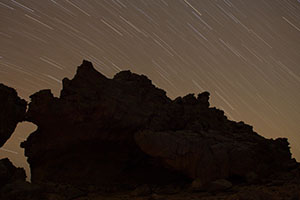 |
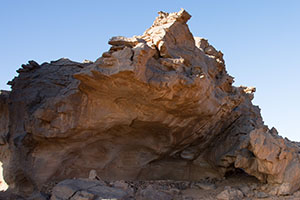 |
| Layers of sand stone, Abandoned villlage near Iherir砂岩の層、イヘリール近くの廃村 | shelter of Iheren イヘーレン岩陰 | 360-degree Virtual Reality360度VR |
MERITS AND DEMERITS OF THE WORK OF HENRI LHOTE
Five reproduction paintings were drawn by the mission of Henri Lhote in 1970. The method of reproduction in 1956-19577 was: 1) Clean and wet the surface with a wet sponge 2)Put a tracing paper on the wall and copy the contours of images 3) Copy the contours on a drawing paper and paint with watercolors. This method is criticized today because it caused damages and/or acceleration of fading. However, Yves Martin, who was a member of the mission in 1970, confirmed that they did not clean or rub the surface with a wet sponge but they did some slight humidification was done only partly.
Jean-Dominique Lajoux, photographer and a member of the mission in 1957, argue that the rock paintings cannot be damaged only by wetting and wetting is good method for revealing the faint paintings when photographing. (MURS D’IMAGES, 2012)
The reproduction work by the mission of Henri Lhote is also criticized for the contamination by the pencils used during the copy work on the wall. This made impossible to analyze directly the organic binder of pigments for dating. (M. Hachid/J-L. Le Quellec, 2010) . This is not the case for the reproduction in 1970, according to Yves Martin.
Today, the old reproduction method is prohibited. Instead, there are possibilities to enhance faint images digitally. DStretch developed by Jon Harman is quite powerful. See the samples: 1) Normal photo 2) DStretched photo 3) Wetted paint (Lajoux)
Even though the method of reproduction was not appropriate, the value of the reproduction by Henri Lhote cannot be diminished. It is a valuable and indispensable guide to understand the fresco.
アンリ・ロートの功罪
1970年に行われたイヘーレンの調査では、長期間滞在して5枚の原寸大模写が作成されている。ロート隊の模写法は、1956-7年の初回調査時では、次のような手順で行われた。①水を含ませたスポンジで壁面を拭い、絵を浮かび上がらせる。②トレーシングペーパーを壁に当てて写し取る。③別の画用紙に写して彩色する。現在では、この手法が壁画を損傷させた、あるいは、損傷を加速させる原因となったと批判されている。 1970年のイヘーレン調査隊メンバーであったイヴ・マルタンは、スポンジで拭ったりはしていない、部分的にわずかに湿らせる程度にとどめた、と証言している。
1957年の調査隊の一員でもあった写真家のJean-Dominique Lajouxは、水に濡らした程度では損傷しない、写真撮影では有効な手法であると主張している。(MURS D’IMAGES, 2012) 確かに、埃の層で覆われているような部分も多く、こうした部分では水に濡らすのは有効で、損傷もなさそうに思われる。一方で、埃におおわれていないように見える部分もあり、スポンジが損傷を与えないとは言い切れない。
また、模写作業では使われた鉛筆などで汚染されており、顔料に含まれた有機成分を直接分析して年代を割り出す手法が使えなくなったとの指摘もある(M. Hachid/J-L. Le Quellec 2010)。 もちろん、現在ではこうした模写手法は禁じられている。それに替わるものとして、画像処理で補完する技術が開発されている。Jon Harman氏のDSTRETCHは岩面画の画像処理専用に開発されたソフトで非常に有効である。僅かに残された顔料の痕跡を拾い出すことができる。次に、①通常の写真、②①をDSTRETCHで処理したもの、③水で濡らして撮影した写真(Lajoux)を示す。
当時の模写法に問題があったとしてもアンリ・ロートの模写自体の価値が損なわれるものではない。模写は壁画を鑑賞するための貴重なガイドの役割を担ってくれる。
**************************************************************************************************************************************
Photo exhibition “The Fresco of Iheren – The Green Sahara revives after 5,000 years” was held in Tokyo and in Kyoto with 1,300 visitors in total. I express my sincere gratitude for the warm appreciation:
http://hanafusa.info/photo-exhibition-fresco-of-iheren/
「イヘーレン岩壁画写真展 ― 5000年の時を超え、緑のサハラが甦る」は東京と京都で2014年9-10月に行われ、1,300人もの多くの方々に観ていただきましたこと、こころよりお礼申し上げます:
http://hanafusa.info/photo-exhibition-fresco-of-iheren/

